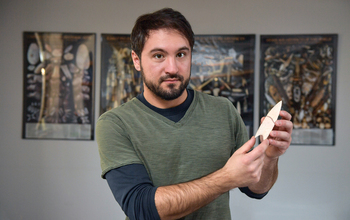Multimedia Gallery
Professor Metin Eren studies Clovis weapon technologies
Metin Eren, director of archaeology and an assistant professor of anthropology at Kent State University's College of Arts and Sciences, studies the engineering, techniques and purposes of Clovis weapon technologies.
More about this image
Metin Eren, director of archaeology and assistant professor in the Department of Anthropology in the College of Arts and Sciences at Kent State University, and colleagues are studying how the nomadic Clovis hunters that crossed the frozen land bridge from Asia to North America approximately 13,500 years survived in a new landscape with new challenges and adapted with stone tools and weapons.
The researchers are seeking to better understand the engineering, techniques and purposes of Clovis weapon technologies by studying stone projectile points such as arrowheads and spear points made by flint knapping, the ancient practice of chipping away at the edges of rocks to shape them into weapons and tools.
In an article published about their research, Eren and co-authors explained the flint knapping technique of "fluting" Clovis points. This singular technological attribute, the flake removal or "flute," is absent from the range of stone-tools used in Pleistocene Northeast Asia, where the Clovis ancestors came from, and therefore could possibly be the first truly American invention.
Archaeologists have long debated why the Clovis added this flute feature -- a thin groove chipped off at the base on both sides-- to their points. It may have first been made by accident. Logically, fluting would make the point very thin and brittle. But after several types of testing, the researchers reported that this thinning of the base can make the point better able to withstand and absorb the shock of colliding with a hard object, such as the bone of a mastodon or bison.
It was the invention of this fluted point that allowed these colonizers to travel great distances with some confidence that their weaponry would hold up at least long enough until they could find the next rock quarry to make new points.
"It was risky and couldn’t have been easy to learn how to do this effectively," says Eren. "Archaeological evidence suggests that up to one out of five points break when you try to chip this fluted base, and it takes at least 30 minutes to produce a finished specimen. So, though it was a time-consuming process and risky technique, successfully fluted Clovis points would have been extremely reliable, especially while traveling great distances into unknown regions on a new continent. They needed points that would hold up and be used over and over again."
Says Eren, "It’s amazing to think that people 12,000 years ago were flaking shock absorbers and engineering stone weapons in a way that it took 21st century modern engineering to figure out."
This research is supported by the U.S. National Science Foundation (grant BCS 1649395).
To learn more about this research, see the Ken State news story Kent State archaeologist explains innovation of 'fluting' ancient stone weaponry. (Date image taken: March 2017; date originally posted to NSF Multimedia Gallery: July 13, 2017)
Credit: Bob Christy/Kent State University
Images and other media in the National Science Foundation Multimedia Gallery are available for use in print and electronic material by NSF employees, members of the media, university staff, teachers and the general public. All media in the gallery are intended for personal, educational and nonprofit/non-commercial use only.
Images credited to the National Science Foundation, a federal agency, are in the public domain. The images were created by employees of the United States Government as part of their official duties or prepared by contractors as "works for hire" for NSF. You may freely use NSF-credited images and, at your discretion, credit NSF with a "Courtesy: National Science Foundation" notation.
Additional information about general usage can be found in Conditions.
Also Available:
Download the high-resolution JPG version of the image. (9.8 MB)
Use your mouse to right-click (Mac users may need to Ctrl-click) the link above and choose the option that will save the file or target to your computer.



 All images in this series
All images in this series